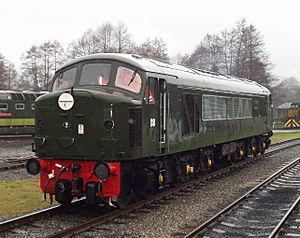British Rail Class 44 facts for kids
Quick facts for kids Derby Type 4British Rail Class 44 |
|
 |
|
| Preserved Class 44 number D8 at Rowsley South, on Peak Rail | |
| Power type | Diesel-electric |
|---|---|
| Builder | British Railways’ Derby Works |
| Total production | 10 |
| Configuration | 1Co-Co1 |
| UIC classification | (1Co)'(Co1)' |
| Gauge | 4 ft 8 1⁄2 in (1,435 mm) |
| Wheel diameter | 3 ft 9 in (1.143 m) |
| Minimum curve | 5 chains (100 m) |
| Wheelbase | 59 ft 8 in (18.19 m) |
| Length | 67 ft 11 in (20.70 m) |
| Width | 8 ft 10+1⁄2 in (2.71 m) |
| Height | 12 ft 10 in (3.91 m) |
| Locomotive weight | 133 long tons (135 t) |
| Fuel capacity | 840 imp gal (3,800 L; 1,010 US gal) |
| Prime mover | Sulzer 12LDA28-A |
| Multiple working | ★ Blue Star |
| Power output | Engine: 2,300 bhp (1,715 kW) At rail: 1,800 hp (1,342 kW) |
| Tractive effort | Maximum: 50,000 lbf (222 kN) |
| Train heating | Steam generator |
| Locomotive brakeforce | 63 long tons-force (628 kN) |
| Train brakes | Vacuum |
| Career | British Railways |
| Number | D1–D10; later 44001–44010 |
| Nicknames | ‘Peak’ |
| Axle load class | Route availability 7 |
The British Rail Class 44 was a type of diesel locomotive used in Britain. These powerful engines were built by British Railways at their Derby Works between 1959 and 1960. They were given names of famous British mountains, which led to their popular nickname: the Peaks.
Contents
What is a Diesel Locomotive?
A locomotive is the part of a train that provides the power to move it. Diesel locomotives, like the Class 44, use a diesel engine to create electricity. This electricity then powers motors that turn the wheels. This design was a big step forward from older steam trains.
Why Were the Peaks Built?
In the late 1950s, British Railways wanted to replace their old steam locomotives. They needed new, modern engines that could pull heavy passenger and freight trains across the country. The Class 44s were part of this big plan to modernize the railway system.
The Modernization Plan
The plan aimed to make train travel faster and more efficient. Diesel locomotives were chosen because they were more reliable and cheaper to run than steam engines. They also didn't need to stop as often for water or fuel.
Meet the Peaks: Names and Numbers
Only 10 Class 44 locomotives were ever built. Each one was given a special name after a British mountain.
- D1 Scafell Pike
- D2 Great Gable
- D3 Helvellyn
- D4 Whernside
- D5 Cross Fell
- D6 Kinder Scout
- D7 Snowdon
- D8 Pen-y-Ghent
- D9 Alnwick Castle (originally Ingleborough)
- D10 Tryfan
Later, their numbers were changed. For example, D1 Scafell Pike became 44001.
How Powerful Were They?
The Class 44s were known for their strength. They had a large Sulzer engine that could produce 2,300 horsepower. This power allowed them to pull long, heavy trains at speeds up to 75 miles per hour. They were designed to handle tough routes, especially in the hilly areas of Britain.
Life on the Rails: What They Did
The Class 44s mainly worked on the Midland Main Line. This route connects London to places like Sheffield and Manchester. They pulled important express passenger trains and heavy freight trains. Their job was to keep goods and people moving across the country.
Working Together
These locomotives could also work in "multiple." This means two or more Class 44s could be linked together. A single driver could control all of them from the front cab. This was useful for extra-heavy trains or steep hills.
The End of an Era: Retirement
The Class 44s were good locomotives, but newer, even more powerful diesel engines were soon developed. These new engines, like the Class 45 and Class 46, were very similar but had some improvements. Because of this, the Class 44s were eventually retired from service. Most of them were taken out of use by the early 1980s.
Preserved Peaks
Even though most Class 44s were scrapped, one special locomotive was saved. Class 44 number D8, named Pen-y-Ghent, is still around today. It has been carefully restored and can be seen at Peak Rail. This allows people to see and learn about these historic engines.
Images for kids



